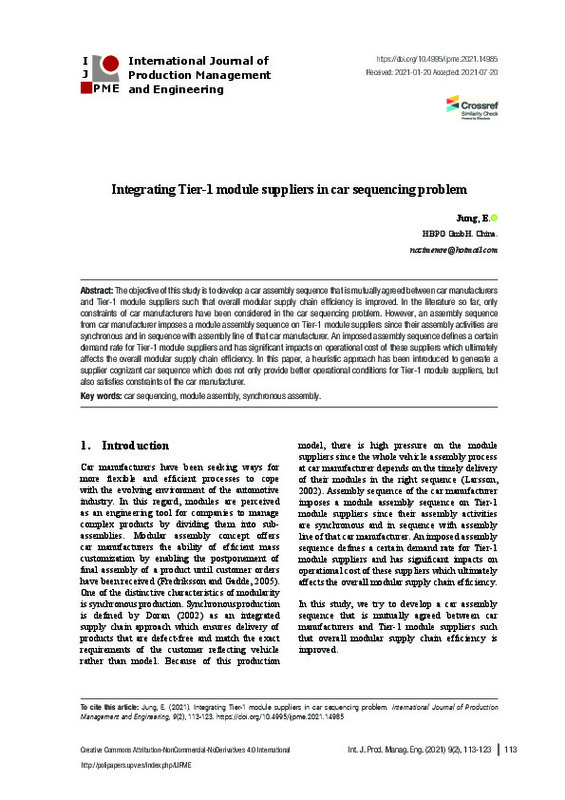JavaScript is disabled for your browser. Some features of this site may not work without it.
Buscar en RiuNet
Listar
Mi cuenta
Estadísticas
Ayuda RiuNet
Admin. UPV
Integrating Tier-1 module suppliers in car sequencing problem
Mostrar el registro sencillo del ítem
Ficheros en el ítem
| dc.contributor.author | Jung, Emrae
|
es_ES |
| dc.date.accessioned | 2021-07-29T09:58:22Z | |
| dc.date.available | 2021-07-29T09:58:22Z | |
| dc.date.issued | 2021-07-28 | |
| dc.identifier.uri | http://hdl.handle.net/10251/170828 | |
| dc.description.abstract | [EN] The objective of this study is to develop a car assembly sequence that is mutually agreed between car manufacturers and Tier-1 module suppliers such that overall modular supply chain efficiency is improved. In the literature so far, only constraints of car manufacturers have been considered in the car sequencing problem. However, an assembly sequence from car manufacturer imposes a module assembly sequence on Tier-1 module suppliers since their assembly activities are synchronous and in sequence with assembly line of that car manufacturer. An imposed assembly sequence defines a certain demand rate for Tier-1 module suppliers and has significant impacts on operational cost of these suppliers which ultimately affects the overall modular supply chain efficiency. In this paper, a heuristic approach has been introduced to generate a supplier cognizant car sequence which does not only provide better operational conditions for Tier-1 module suppliers, but also satisfies constraints of the car manufacturer. | es_ES |
| dc.language | Inglés | es_ES |
| dc.publisher | Universitat Politècnica de València | es_ES |
| dc.relation.ispartof | International Journal of Production Management and Engineering | es_ES |
| dc.rights | Reconocimiento - No comercial - Sin obra derivada (by-nc-nd) | es_ES |
| dc.subject | Car sequencing | es_ES |
| dc.subject | Module assembly | es_ES |
| dc.subject | Synchronous assembly | es_ES |
| dc.title | Integrating Tier-1 module suppliers in car sequencing problem | es_ES |
| dc.type | Artículo | es_ES |
| dc.identifier.doi | 10.4995/ijpme.2021.14985 | |
| dc.rights.accessRights | Abierto | es_ES |
| dc.description.bibliographicCitation | Jung, E. (2021). Integrating Tier-1 module suppliers in car sequencing problem. International Journal of Production Management and Engineering. 9(2):113-123. https://doi.org/10.4995/ijpme.2021.14985 | es_ES |
| dc.description.accrualMethod | OJS | es_ES |
| dc.relation.publisherversion | https://doi.org/10.4995/ijpme.2021.14985 | es_ES |
| dc.description.upvformatpinicio | 113 | es_ES |
| dc.description.upvformatpfin | 123 | es_ES |
| dc.type.version | info:eu-repo/semantics/publishedVersion | es_ES |
| dc.description.volume | 9 | es_ES |
| dc.description.issue | 2 | es_ES |
| dc.identifier.eissn | 2340-4876 | |
| dc.relation.pasarela | OJS\14985 | es_ES |
| dc.description.references | Benoist, T., Gardi, F., Megel, R., Nouioua, K. 2011. LocalSolver 1.x: a black-box local-search solver for 0-1 programming. 4OR - A Quarterly Journal of Operations Research, 9(299). https://doi.org/10.1007/s10288-011-0165-9 | es_ES |
| dc.description.references | Boysen, N., Fliedner, M., Scholl, A. 2009. Sequencing mixed-model assembly lines: survey, classification and model critique. European Journal of Operational Research, 192, 349-373. https://doi.org/10.1016/j.ejor.2007.09.013 | es_ES |
| dc.description.references | Doran, D. 2002. Manufacturing for synchronous supply: a case study of Ikeda Hoover Ltd. Integrated Manufacturing Systems, 13(1), 18-24. https://doi.org/10.1108/09576060210411477 | es_ES |
| dc.description.references | Drexl, A., Kimms, A. 2001. Sequencing JIT mixed-model assembly lines under station-load and part-usage constraints. Management Science, 47,(3), 480-491. https://doi.org/10.1287/mnsc.47.3.480.9777 | es_ES |
| dc.description.references | Estellon, B., Gardi, F. 2006. Car sequencing is NP-hard: a short proof. Journal of the Operational Research Society, 64, 1503-1504. https://doi.org/10.1057/jors.2011.165 | es_ES |
| dc.description.references | Estellon, B., Gardi, F., Nouioua, K. 2006. Large neighborhood improvements for solving car sequencing problems. RAIRO - Operations Research, 40(4), 355-379. https://doi.org/10.1051/ro:2007003 | es_ES |
| dc.description.references | Estellon, B., Gardi, F., Nouioua, K. 2008. Two local search approaches for solving real-life car sequencing problems. European Journal of Operational Research, 191(3), 928-944. https://doi.org/10.1016/j.ejor.2007.04.043 | es_ES |
| dc.description.references | Fredriksson, P., Gadde, L.E. 2005. Flexibility & rigidity in customization and build-to-order production. Science Direct Industrial Marketing Management, 34, 695-705. https://doi.org/10.1016/j.indmarman.2005.05.010 | es_ES |
| dc.description.references | Gagne, C., Gravel, M., Price, W. 2006. Solving real car sequencing problems with ant colony optimization. European Journal of Operational Research, 174(3), 1427-1448. https://doi.org/10.1016/j.ejor.2005.02.063 | es_ES |
| dc.description.references | Gottlieb, J., Puchta, M., Solnon., C. 2003. A study of greedy, local search and ant colony optimization approaches for car sequencing problems. In Applications of Evolutionary Computing, Lecture Notes in Computer Science, 2611. Springer, Berlin, Heidelberg. https://doi.org/10.1007/3-540-36605-9_23 | es_ES |
| dc.description.references | Hellingrath, B. 2008. Key principles of flexible production and logistics networks. Build to Order: The Road to the 5-Day Car, Springer-Verlag, London, 177-180. https://doi.org/10.1007/978-1-84800-225-8_10 | es_ES |
| dc.description.references | Larsson, A. 2002. The development and regional significance of the automotive industry: supplier parks in Western Europe. International Journal of Urban and Regional Research, 26(4), 767-784. https://doi.org/10.1111/1468-2427.00417 | es_ES |
| dc.description.references | Monden, Y. 1998. Toyota production systems: an integrated approach to just-in-time, 3rd edition. Industrial Engineering & Management Press, Norcoss | es_ES |
| dc.description.references | Niemann, J., Seisenberger, S., Schlegel, A., Putz, M. 2019. Development of a method to increase flexibility and changeability of supply contracts in the automotive industry. 52nd CIRP Conference on Manufacturing Systems, Ljubljana, Slovenia, June 12-14. https://doi.org/10.1016/j.procir.2019.03.045 | es_ES |
| dc.description.references | Parrello, B.D., Kabat, W.C., Wos, L. 1986. Job-shop scheduling using automated reasoning: a case study of the car-sequencing problem. Journal of Automated Reasoning, 2(1), 1-42. https://doi.org/10.1007/BF00246021 | es_ES |
| dc.description.references | Regin, J.C., Puget, J.F. 1997. A filtering algorithm for global sequencing constraints. In: Smolka G. (eds) Principles and Practice of Constraint Programming-CP97. Lecture Notes in Computer Science, 1330. Springer, Heidelberg. https://doi.org/10.1007/BFb0017428 | es_ES |
| dc.description.references | Solnon, C., Cung, V.D., Nguyen A., Artigues, C. 2008. The car sequencing problem: overview of state-of-the-art methods and industrial casestudy of the ROADEEF'2005 challenge problem. European Journal of Operational Research, 191, 912-927. https://doi.org/10.1016/j.ejor.2007.04.033 | es_ES |








